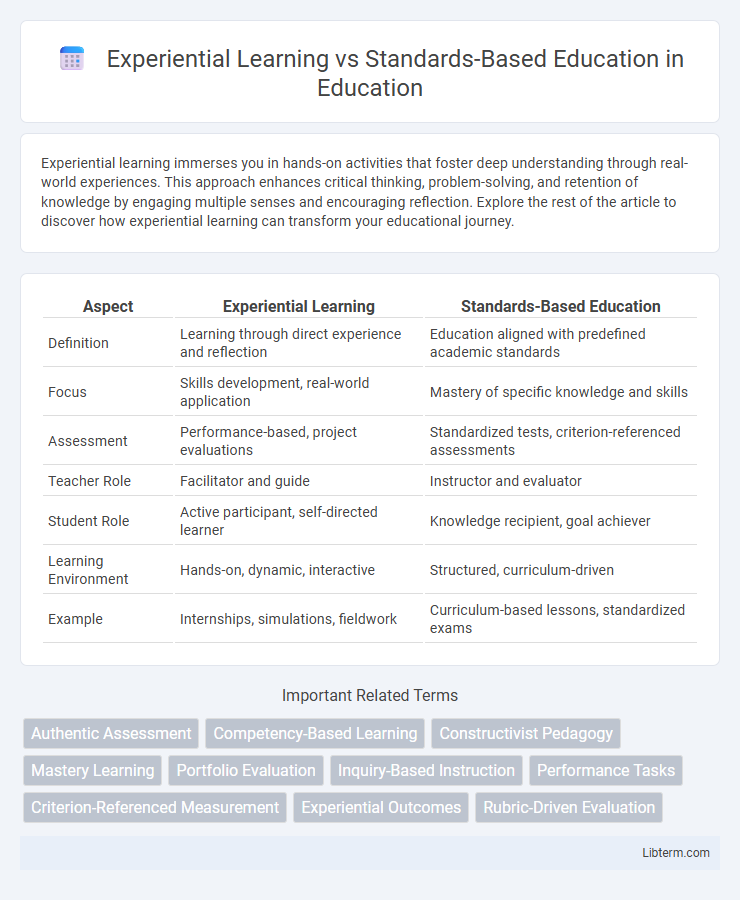Experiential learning immerses you in hands-on activities that foster deep understanding through real-world experiences. This approach enhances critical thinking, problem-solving, and retention of knowledge by engaging multiple senses and encouraging reflection. Explore the rest of the article to discover how experiential learning can transform your educational journey.
Table of Comparison
| Aspect | Experiential Learning | Standards-Based Education |
|---|---|---|
| Definition | Learning through direct experience and reflection | Education aligned with predefined academic standards |
| Focus | Skills development, real-world application | Mastery of specific knowledge and skills |
| Assessment | Performance-based, project evaluations | Standardized tests, criterion-referenced assessments |
| Teacher Role | Facilitator and guide | Instructor and evaluator |
| Student Role | Active participant, self-directed learner | Knowledge recipient, goal achiever |
| Learning Environment | Hands-on, dynamic, interactive | Structured, curriculum-driven |
| Example | Internships, simulations, fieldwork | Curriculum-based lessons, standardized exams |
Introduction to Experiential Learning and Standards-Based Education
Experiential learning emphasizes hands-on, real-world experiences to deepen understanding and foster critical thinking, contrasting with standards-based education that prioritizes meeting predetermined academic benchmarks and learning outcomes. In experiential learning, students engage actively with content through practical application, promoting retention and skill development beyond rote memorization. Standards-based education systematically measures student progress against clearly defined criteria to ensure mastery of specific knowledge and competencies.
Defining Experiential Learning
Experiential learning is an educational approach emphasizing hands-on experiences and real-world application of knowledge, fostering critical thinking and problem-solving skills. It contrasts with standards-based education, which centers on meeting predefined academic benchmarks and assessing student performance against set criteria. By engaging learners directly in active tasks, experiential learning promotes deeper understanding and retention beyond traditional standardized assessments.
Understanding Standards-Based Education
Standards-Based Education centers on clearly defined learning goals that specify what students must know and be able to do at each grade level, ensuring consistent academic expectations across diverse classrooms. This approach uses specific benchmarks and performance assessments to measure student mastery, allowing educators to identify gaps and provide targeted support. By aligning instruction with established standards, it promotes accountability and helps students achieve proficiency through structured, measurable progress.
Core Principles of Experiential Learning
Experiential learning centers on active, hands-on experiences that promote critical thinking, reflection, and real-world problem solving, contrasting with the rigid outcomes focus typical of standards-based education. Core principles include learning through direct engagement, fostering intrinsic motivation, and integrating continuous feedback to adapt and deepen understanding. This approach emphasizes student agency and contextualized knowledge, prioritizing skills development over standardized assessment metrics.
Key Features of Standards-Based Education
Standards-Based Education emphasizes clear, measurable learning goals aligned with academic standards to ensure consistency and accountability across classrooms. It prioritizes regular assessments and feedback, enabling educators to monitor student progress toward mastering specific skills and knowledge. This approach supports personalized instruction by identifying individual student needs and guiding targeted interventions based on standardized benchmarks.
Benefits of Experiential Learning
Experiential learning enhances student engagement by providing hands-on activities that promote deeper understanding and retention of knowledge. It fosters critical thinking, problem-solving skills, and real-world application, which standards-based education may not fully address. This method supports personalized learning, allowing students to connect academic content with their own experiences for meaningful educational growth.
Advantages of Standards-Based Education
Standards-Based Education ensures clear learning goals aligned with state and national benchmarks, promoting consistent achievement measurement and accountability across diverse classrooms. It provides specific criteria for assessing student progress, enabling targeted interventions and personalized instruction to address learning gaps effectively. This approach supports equitable education by setting uniform expectations, fostering transparency for students, parents, and educators alike.
Comparative Analysis: Experiential Learning vs Standards-Based Education
Experiential learning emphasizes hands-on, real-world experiences that foster critical thinking and problem-solving, while standards-based education focuses on measurable outcomes aligned with specific academic benchmarks. Experiential learning promotes adaptability and personal growth through active engagement, contrasting with the structured assessment and uniformity characteristic of standards-based models. Research indicates that combining both methods can enhance student motivation and achievement by balancing practical skills with academic rigor.
Challenges and Limitations of Both Approaches
Experiential learning faces challenges such as inconsistent assessment methods and difficulty in aligning hands-on activities with standardized curriculum benchmarks. Standards-based education often struggles with inflexibility, limiting opportunities for creativity and personalized skill development due to rigid performance metrics. Both approaches encounter limitations in balancing measurable outcomes with fostering critical thinking and practical application skills.
Integrating Experiential Learning with Standards-Based Education
Integrating experiential learning with standards-based education enhances student engagement by applying real-world experiences to meet academic benchmarks and competencies. This approach supports mastery of standards through hands-on activities, project-based learning, and reflective practices, fostering deeper understanding and retention. Schools implementing this integration report improved critical thinking skills, increased motivation, and better alignment with both state education standards and 21st-century skill requirements.
Experiential Learning Infographic

 libterm.com
libterm.com